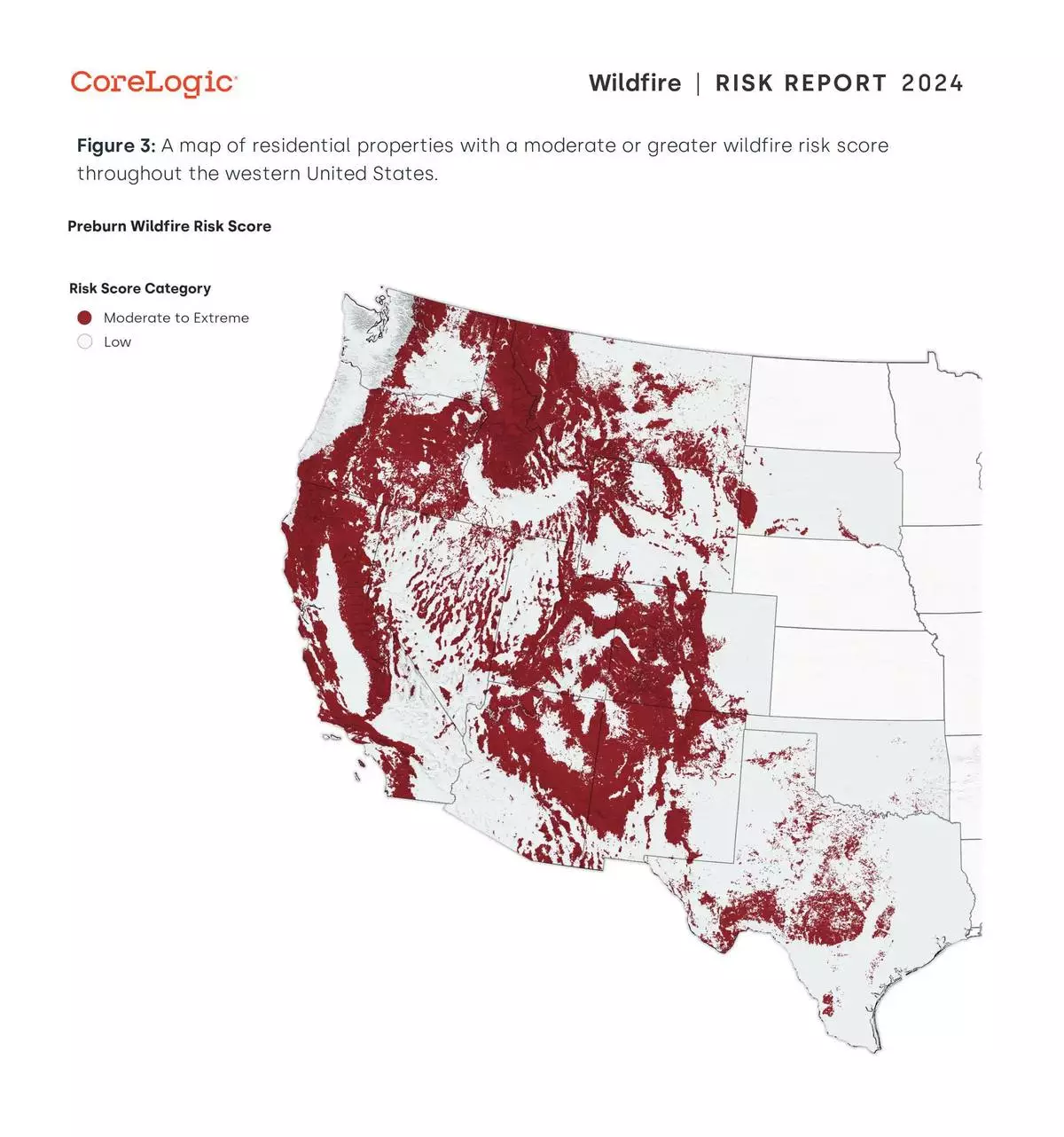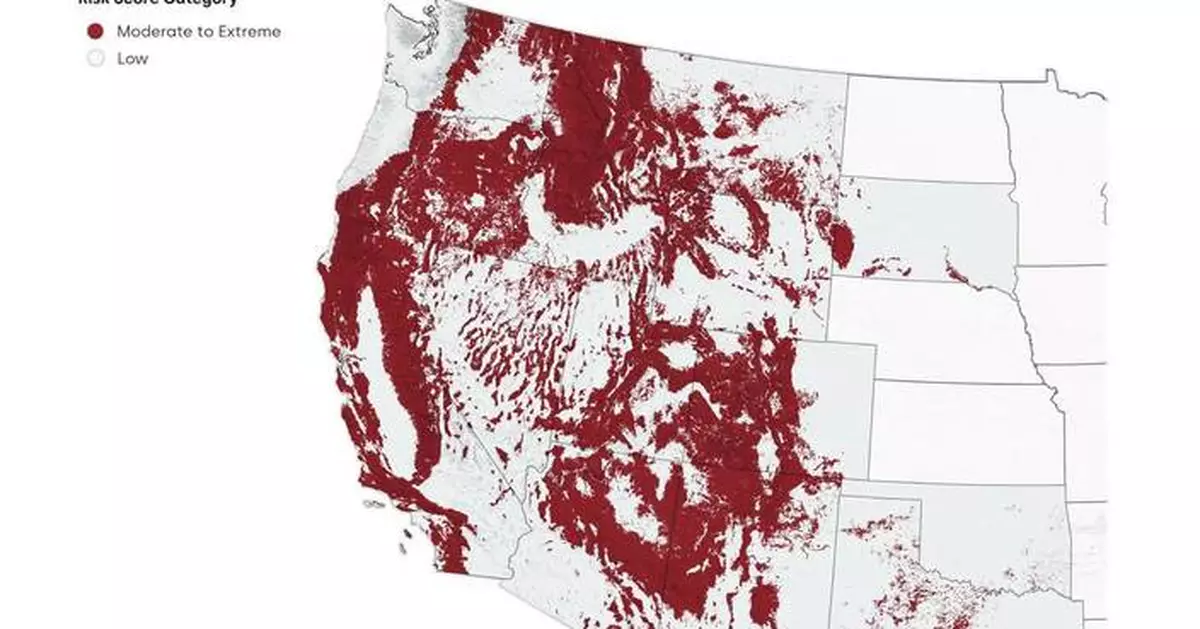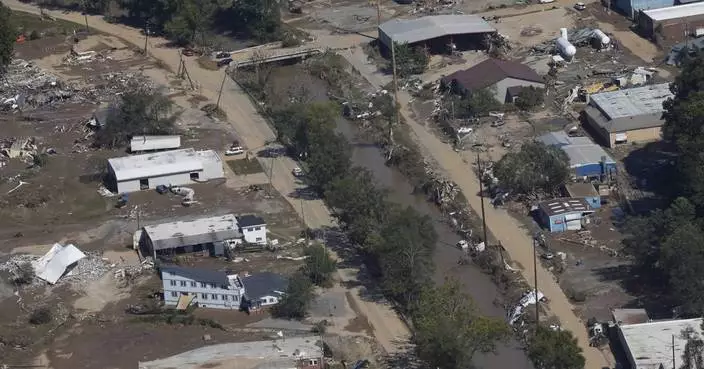IRVINE, Calif.--(BUSINESS WIRE)--Aug 13, 2024--
Natural disasters are becoming more intense as a result of changing weather patterns and wildfires are no exception. The 2024 CoreLogic Wildfire Risk Report found more than 2.6 million homes across 14 states are at moderate to very high risk of wildfire damage during the 2024 wildfire season, with a total reconstruction cost of $1.3 trillion. With those figures as a backdrop, the report also highlights the importance of mitigation techniques, both on an individual property and community wide basis—which have benefits for both homeowners and insurers.
This press release features multimedia. View the full release here: https://www.businesswire.com/news/home/20240813649322/en/
The western United States has the greatest wildfire risk with three states comprising 70% of the risk. The following states having the highest number of homes at moderate or greater risk of wildfire exposure:
These states face an elevated level of risk because of the high number of homes in undeveloped areas, or with exposure to Wildland-Urban Interface, where homes are near wildlife such as trees, vegetation and other flammable materials. The Los Angeles metropolitan area leads the nation with the highest number of homes at risk, with more than 245,000 homes with moderate or greater risk of wildfire, representing a total reconstruction value of $186.6 billion although not all homes that experience a loss in a wildfire scenario will be a total loss.
“In recent years, we’ve seen wildfires occur in unexpected places, reinforcing the need to understand the risk landscape and take mitigation action. Both insurers and consumers have a role to play to ensure adequate protection,” said Jon Schneyer, CoreLogic’s director of catastrophe response. “These numbers may seem overwhelming, but research shows that mitigation efforts make a real difference in potential losses from wildfires. The good news is there are actions people can take to lessen the risk.”
Effective mitigation strategies
There have been multiple devastating wildfires in recent years that have highlighted the need for individuals and communities to take mitigation action. For example, the Camp Fire of 2018 decimated more than 90% of the town of Paradise, California. A recent collaborative study with the Town of Paradise, Milliman, Inc, and CoreLogic 1 found combining individual home- and community-level mitigation strategies led to a 75% reduction in expected loss per property in high-risk areas like Paradise, which can also lead to lower insurance premiums.
Effective mitigation is a combined effort between communities and individuals. Some mitigation tactics for individuals include:
Community-level mitigation efforts include:
Additional mitigation tactics can be found through Insurance Institute for Business & Home Safety’s (IBHS) Wildfire Prepared Home Program™ at wildfireprepared.org.
To learn more about wildfire risk and prevention, read the full 2024 Wildfire Risk Report.
About CoreLogic
CoreLogic is a leading provider of property insights and innovative solutions, working to transform the property industry by putting people first. Using its network, scale, connectivity and technology, CoreLogic delivers faster, smarter, more human-centered experiences, that build better relationships, strengthen businesses, and ultimately create a more resilient society. For more information, please visit www.corelogic.com.
©2024 CoreLogic, Inc. All rights reserved. While all of the content, data, and information is believed to be accurate, CoreLogic makes no guarantee, representation, or warranty, express or implied, including but not limited to as to the completeness, accuracy, applicability, or fitness, in connection with the content, data, or information or the products referenced herein and assumes no responsibility or liability whatsoever for the content, data, information, or products referenced herein or any reliance thereon. CoreLogic ® is the trademark of CoreLogic, Inc. or its affiliates or subsidiaries.
1https://www.milliman.com/-/media/milliman/pdfs/2023-articles/5-2-23_report-town-of-paradise-20230406.ashx?la=en&hash=A602289482CACACBCAD518C153B12A22


CoreLogic's map of residential properties with a moderate or greater wildfire risk score throughout the western United States. (Graphic: Business Wire)
Manchester City’s stunning slump continued Saturday with a 2-1 loss to Aston Villa in the Premier League.
Goals from Jhon Duran and Morgan Rogers at Villa Park consigned the four-time defending champion to a ninth defeat in 12 games in a season that is unravelling. Pep Guardiola’s team has won just once during that run.
“We have to stay positive, even though it’s difficult, and we have to keep working hard,” City striker Erling Haaland said.
Phil Foden pulled a goal back for City in stoppage time, but it wasn’t enough to spark a late comeback.
City dropped to sixth in the standings — nine points below leader Liverpool, having played two games more. Villa climbed to fifth.
Nottingham is up to third after ending Brentford's unbeaten home record with a 2-0 win, and Newcastle routed Ipswich 4-0. West Ham drew 1-1 with Brighton.
City’s remarkable fall shows little sign of stopping, with Guardiola admitting last week that he had not been good enough to turn his team’s form around.
Defeat meant the once-dominant City is without a win in any of its last eight away games in all competitions. While it looks unlikely to win a fifth-straight title, a place in the top four and Champions League qualification could also be in jeopardy.
“We concede the goals we don’t concede in the past, we (don’t) score the goals we score in the past,” Guardiola said. “We have to think positive and I have incredible trust in the guys. Some of them have incredible pride and desire to do it. We have to find a way, step by step, sooner or later to find a way back.”
Only once under Guardiola has City managed to win the title when losing six times in the league. That was in the 2020-21 campaign, when it lost two of its last three games, having already been confirmed champion.
City lost nine times when Liverpool won the title in ’19-20, but its sixth defeat didn’t come until the February of that campaign. Guardiola also lost six times in the league in his first season in English soccer in ’16-17 and City finished third in the standings.
The latest defeat could have been even more emphatic against a dominant Villa.Duran scored his sixth goal in as many starts in the 16th minute from Rogers’ assist.
Duran had a goal disallowed for offside in the second half and Rogers hit the post before doubling Villa’s lead in the 65th.
Foden’s goal in the third minute of added time came too late for City.
James Robson is at https://twitter.com/jamesalanrobson
AP soccer: https://apnews.com/hub/soccer

Newcastle United's Jacob Murphy celebrates scoring during the English Premier League soccer match between Ipswich Town and Newcastle United at Portman Road, Ipswich, England, Saturday Dec. 21, 2024. (Bradley Collyer/PA via AP)

Newcastle United's Alexander Isak celebrates scoring during the English Premier League soccer match between Ipswich Town and Newcastle United at Portman Road, Ipswich, England, Saturday Dec. 21, 2024. (Bradley Collyer/PA via AP)

Nottingham Forest's Anthony Elanga, centre right, shoots on target during during the English Premier League soccer match between Brentford and Nottingham Forest at the Gtech Community Stadium, London, Saturday Dec. 21, 2024. (John Walton/PA via AP)

Nottingham Forest's Anthony Elanga, right, celebrates after scoring his sides second goal during during the English Premier League soccer match between Brentford and Nottingham Forest at the Gtech Community Stadium, London, Saturday Dec. 21, 2024. (John Walton/PA via AP)

Manchester City's head coach Pep Guardiola, center, and players leave the field at the end of the English Premier League soccer match between Aston Villa and Manchester City, at Villa Park in Birmingham, England, Saturday, Dec. 21, 2024. (AP Photo/Rui Vieira)

Aston Villa's Morgan Rogers, center, celebrates with teammates after scoring his side's second goal during the English Premier League soccer match between Aston Villa and Manchester City, at Villa Park in Birmingham, England, Saturday, Dec. 21, 2024. (AP Photo/Rui Vieira)

Aston Villa's Jhon Duran celebrates after scoring the opening goal during the English Premier League soccer match between Aston Villa and Manchester City, at Villa Park in Birmingham, England, Saturday, Dec. 21, 2024. (AP Photo/Rui Vieira)

Manchester City's head coach Pep Guardiola reacts during the English Premier League soccer match between Aston Villa and Manchester City, at Villa Park in Birmingham, England, Saturday, Dec. 21, 2024. (AP Photo/Rui Vieira)

Manchester City's Phil Foden reacts after Aston Villa's Morgan Rogers scoring his side's second goal during the English Premier League soccer match between Aston Villa and Manchester City, at Villa Park in Birmingham, England, Saturday, Dec. 21, 2024. (AP Photo/Rui Vieira)




















